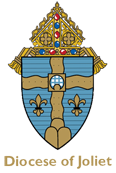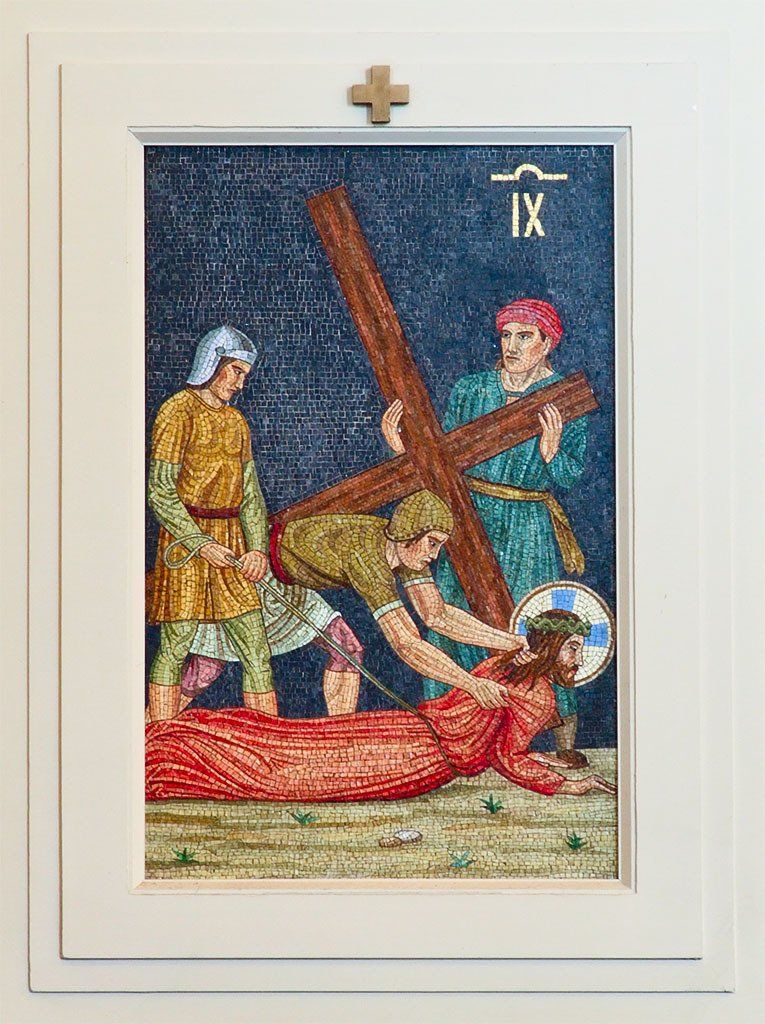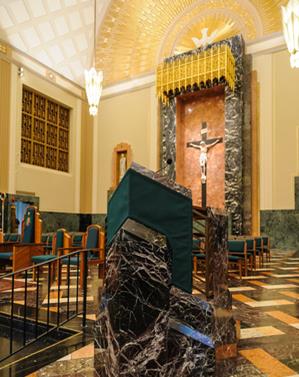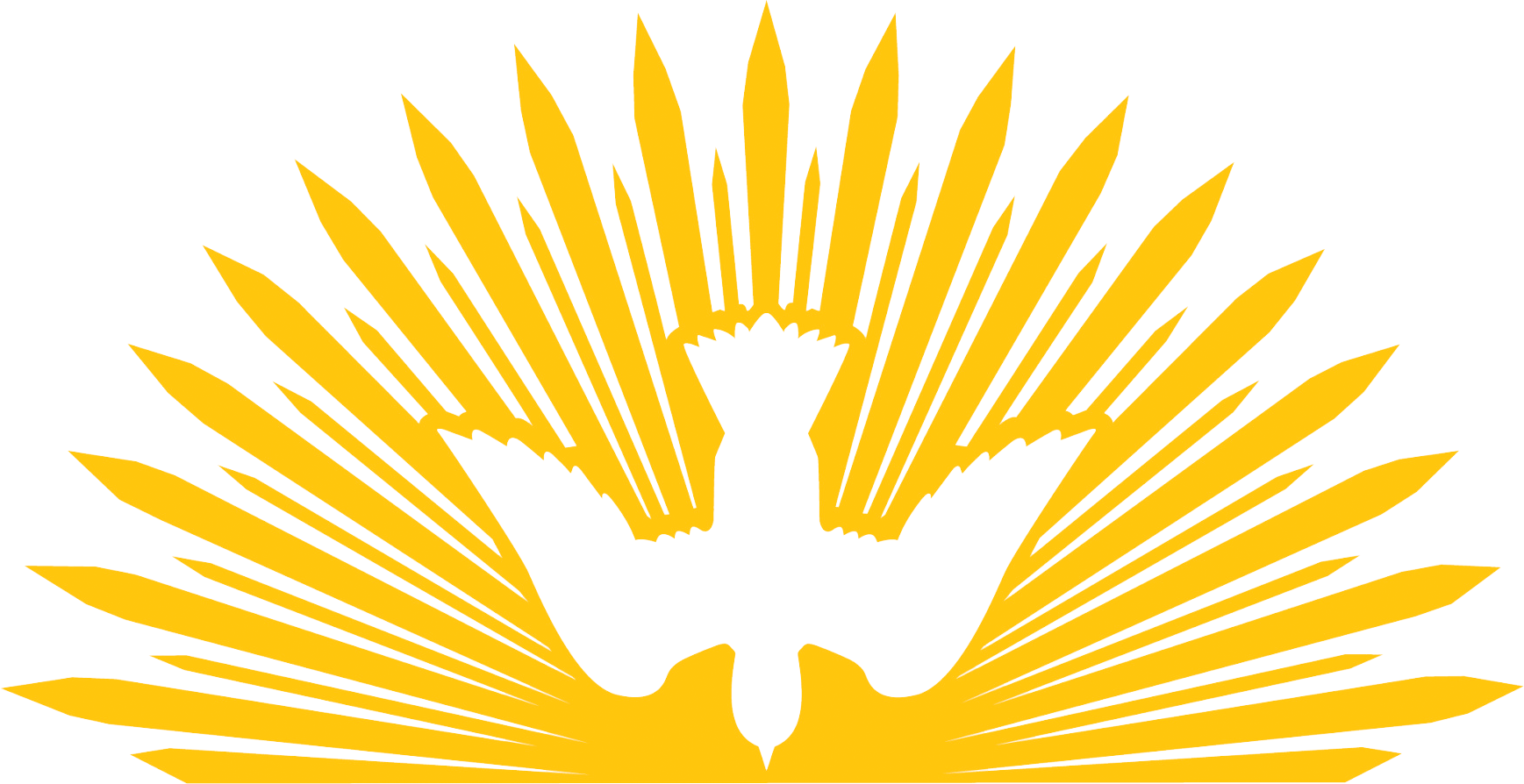Statues
Peter and Paul (located to the right and left of Christ) represent two strikingly different approaches to discipleship. Peter had to learn slowly, make many mistakes along the way, but always experienced the compassionate forgiveness and encouragement of Jesus. Paul, on the other hand, came to the Faith immediately and never backed away from his zeal for Christ after that. Many of us can see both these great Apostles in ourselves. Like Peter, we sometimes fail but yet persevere. Like Paul, we must always be on fire for the Lord, and proclaim Him to everyone and in every situation, no matter how difficult it can sometimes be to do so.
Jesus entrusted a specific authority to Peter: "I will give you the keys of the kingdom of heaven, and whatever you bind on earth shall be bound in heaven, and whatever you loose on earth shall be loosed in heaven." The "power of the keys" designates authority to govern the house of God, which is the Church. Jesus, the Good Shepherd, confirmed this mandate after his Resurrection: "Feed my sheep." The power to "bind and loose" connotes the authority to absolve sins, to pronounce doctrinal judgments, and to make disciplinary decisions in the Church. Jesus entrusted this authority to the Church through the ministry of the apostles and in particular through the ministry of Peter, the only one to whom he specifically entrusted the keys of the kingdom. Thus, it is Peter who symbolically holds the keys to heaven in the statue to the right of Christ.
St. Paul untiring interest in and paternal affection for the churches established by him have given us fourteen canonical Epistles. It is, however, quite certain that he wrote other letters which are no longer extant. In his Epistles, St. Paul shows himself to be a profound religious thinker and he has had an enduring formative influence in the development of Christianity. Thus, Paul carries a sword, as the defender of faith.
St. Joseph was Jesus' foster father. He is the saint of fathers, carpenters, workers.
Pope Pius X - Two of the most outstanding accomplishments of this saintly Pope were the inauguration of the liturgical renewal and the restoration of frequent communion from childhood. He also waged an unwavering war against the heresy and evils of Modernism, gave great impetus to biblical studies, and brought about the codification of Canon Law. His overriding concern was to renew all things in Christ. Above all, his holiness shone forth conspicuously. From St. Pius X we learn again that "the folly of the Cross", simplicity of life, and humility of heart are still the highest wisdom and the indispensable conditions of a perfect Christian life, for they are the very source of all apostolic fruitfulness.
St. Francis Xavier (patron of the Joliet Diocese) was one of the first Jesuit missionaries. In India in 1542 he preached to the natives and attempted to reform his fellow Europeans, living among the natives and adopting their customs on his travels. During the next decade he converted tens of thousands to Christianity. Working against great difficulties, language problems (contrary to legend, he had no proficiency in foreign tongues ), inadequate funds, and lack of cooperation, often actual resistance, from European officials, he left the mark of his missionary zeal and energy on areas which clung to Christianity for centuries. He was canonized in 1622 and proclaimed patron of all foreign missions by Pope Pius X.
St. Therese of Lisieux was known as "the little flower". She had a very short life but was very dedicated to Christ. She was known for saying that she wanted to spend her heaven doing good on earth. St. Therese had a special love of the missions, and authored special letters and prayers in support of missionaries. She reminds us that if feel we can do nothing; it is the little things that keep God's kingdom growing. She is the saint of foreign missions and florists.
St. John Vianney (Patron of priests) was universally known as the "Cure of Ars. " He was made parish priest of Ars, a remote French hamlet, where his reputation as a confessor and director of souls made him known throughout the Christian world. He was a wonderworker loved by the crowds, but he retained a childlike simplicity, and he remains to this day the living image of the priest after the heart of Christ. He heard confessions of people from all over the world for the sixteen hours each day. His life was filled with works of charity and love. It is recorded that even the staunchest of sinners were converted at his mere word.
St. Mary Blessed Mother is our purest most powerful intercessor after our Lord. She is Jesus' mother and The Mother, of God, Mother of Jesus, wife of St. Joseph, and the greatest of all Christian saints. The Virgin Mother "was, after her Son, exalted by divine grace above all angels and men". Born in Jerusalem, Mary was presented in the Temple and took a vow of virginity. Living in Nazareth, Mary was visited by the archangel Gabriel, who announced to her that she would become the Mother of Jesus, by the Holy Spirit. She became betrothed to St. Joseph and went to visit her cousin, Elizabeth, who was bearing St. John the Baptist. Mary and St. Joseph went to Bethlehem, his city of lineage, where she gave birth to Jesus and was visited by the Three Kings. The belief that Mary's body was assumed into heaven is one of the oldest traditions of the Catholic Church. Pope Pius XII declared this belief Catholic dogma in 1950. The feast of the Assumption is celebrated on August 15. The dogma of the Immaculate Conception - that Mary, as the Mother of the Second Person of the Holy Trinity, was free of original sin at the moment of her conception was proclaimed by Pope Pius IX in 1854. The feast of the Immaculate Conception is celebrated on December 8. The birthday of Mary is an old feast in the Church, celebrated on September 8 since the seventh century. Pope Pius XII dedicated the entire human race to Mary in 1944. The Church has long taught that Mary is truly the Mother of God. St. Paul observed that "God sent His Son, born of a woman," expressing the union of the human and the divine in
Christ. Because of this role exemplified by her acceptance of Christ into her womb, her offering of him to God at the Temple, her urging him to perform his first miracle, and her standing at the foot of the Cross at Calvary Mary was joined fully in the sacrifice by Christ of himself. Pope Benedict XV wrote in 1918: "To such an extent did Mary suffer and almost die with her suffering and dying Son; to such extent did she surrender her maternal rights over her Son for man's salvation, and immolated him - insofar as she could in order to appease the justice of God, that we might rightly say she redeemed the human race together with Christ".
Infant of Prague - Prague is the capitol city of the Czech Republic, which is at the very central of Europe with Germany, Poland, Russia and Austria as its neighbors. The history of the Infant Jesus of Prague started in the 17th century when a statue of the Infant Jesus was brought into Bohemia (now Czech Republic) and eventually was given to the Carmelites in Prague. Since then, the statue has remained in Prague and has drawn many devotees worldwide to go and honor the Holy Child. Many graces, blessings, favors and miraculous healings have been received by many who petitioned before the Infant Jesus.
The exact origin of the original Infant Jesus statue was not truly known, but historical sources point to a small 28cm high sculpture of the Holy Child with a bird in his right hand carved in around the year 1340. Many other Infant Jesus sculptures were also carved by famous masters throughout Europe in the Middle Ages. The popularity of the Child Jesus grew in the Baroque period in Spain which may have been caused by the visions of St. Teresa of Avila. A number of sculptures made in Spain eventually found their way to Prague. The Infant Jesus was solemnly coronated on April 4, 1655 by the Archbishop Josef Corta acting for Cardinal Harrach III who was sick. After that period, Prague went through more wars and unrest but the church and the Infant Jesus chapel was miraculously protected. In 1776 the altar was rebuilt using marble and two huge sculptures of the Blessed Virgin Mary and St. Joseph were placed to the left and right sides of the altar. The Holy Infant was kept in a glass case standing on a pedestal engraved with crystals, and surrounding the Infant were twenty angels in gold. Since then copies of the Infant Jesus were made and distributed throughout European churches. The Spanish colonial efforts later brought the Infant Jesus to the Philippines and to Central America. And since then, the devotion has kept spreading to all parts of the world.
INFANT OF PRAGUE NOVENA PRAYER: 0 Jesus, Who has said, "Ask and you shall receive, seek and you shall find, knock and it shall be opened," through the intercession of Mary, Your Most Holy Mother, I knock, I seek, I ask that my prayer be granted.
Sacred heart of Jesus -
Jesus knew and loved us each and all during his life, his agony and his Passion, and gave himself up for each one of us: "The Son of God... loved me and gave himself for me." He has loved us all with a human heart. For this reason, the Sacred Heart of Jesus, pierced by our sins and for our salvation, "is quite rightly considered the chief sign and symbol of that... love with which the divine Redeemer continually loves the eternal Father and all human beings" without exception.























